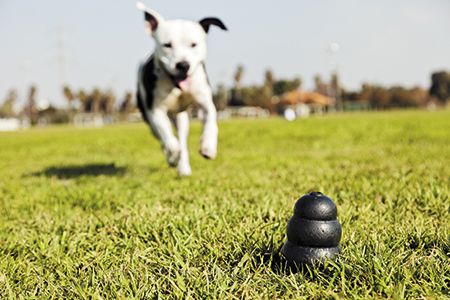The key to turning ambitions into accomplishments? Focus
By identifying only one or two goals, you allow your veterinary team to put all of their energy, attention and resources toward achieving the outcomes that will make the biggest difference in your practice.

With your eyes on one prize, it will be easier to sink your teeth into improving your practice. (Shutterstock.com)Increasing client compliance, maintaining a high-performing staff and improving workplace morale are all great goals that veterinary practices everywhere hope to achieve. The trick, of course, lies in knowing how to turn ambitions into accomplishments.
As discussed in last month's column, establishing just one or two key areas of focus, or “wildly important goals” (WIGs), provides clarity so everyone in your practice can work toward your top priorities. (This practice is also the first of the “Four Disciplines of Execution” developed by Franklin Covey.) A narrow focus allows your team to concentrate their energy, attention and resources on achieving your top desired outcomes. Otherwise, there's a good chance you'll keep doing the same old thing with the same old results.
Pick a WIG
Narrowing your list of wants down to one or two WIGs is a task in itself. A good place to start is to ask yourself, “What's the one area where change would have the greatest impact if every other area of our practice remained the same?”
The answer to this question will vary from practice to practice. One clinic may want to focus on retaining clients, so building repeat visits and loyalty might be its WIG. Another may enjoy a good, loyal base of clients yet aspire to grow and add new patients. A third practice looking to increase employee engagement and avoid turnover might select increasing employee satisfaction as its WIG.
Your WIG should also:
- Align with your mission
- Have a realistic breadth of focus
- Have a practical time frame.
Keep in mind that your WIG could have indirect benefits. For example, a practice experiencing a low level of client compliance, which threatens patient health and impacts practice finances, could make increasing the number of annual wellness visits its WIG. Why? More wellness visits means more contact with clients and thus more opportunities to provide care guidelines and dispense valuable advice, thereby (hopefully) improving client compliance as a byproduct.
Don't keep your WIG a secret
Once your WIG is set, it's vitally important that your entire team know what it is, why you chose it and how they can contribute to its realization. Take the time to demonstrate to each employee how he or she is integral to achieving this goal.
Map out a plan
Mapping out a plan of attack can help you maintain control over your WIG pursuit. In the scenario outlined above, this could look like exploring and applying various ways to get clients in the door for wellness visits. Concurrently, the veterinary team could concentrate on forward booking appointments and providing owners with easy-to-follow home-care materials.
Beware of traps
These seemingly benign things can slow you down:
Urgent tasks. Urgent day-to-day tasks consume 80 percent of our energy on average, so we must fight the instinct to place equal importance on every task. Be clear about what matters most.
Random good ideas. While concentrating on one or two top goals, you'll have to learn to say “no” or “not now” to some of the new and good ideas that come along. Even good ideas can distract you from achieving your WIGs.
Multitasking. There's an old proverb that says, “If you chase two rabbits, you won't catch either one.” When we multitask, we're constantly switching focus, which wastes time as we reorient ourselves to the new activity. You can't significantly improve everything at once.
Next steps
Once you've determined your WIG, the AVMA has a host of practice management tools to help you turn it into an accomplishment. Strategies for pricing, business management or marketing can all be found on the AVMA website, avma.org. In addition, a resource toolbox created by Partners for Healthy Pets can help your entire team with tactics like forward booking, reviving inactive clients and setting up monthly payment programs for preventive healthcare.
Dr. Matthew Salois is chief economist and Veterinary Economics Division director at the AVMA. He has worked in private industry, government and academia, most recently serving as director of global scientific affairs and policy at Elanco Animal Health. Before that he was chief economist with the Florida Department of Citrus. Dr. Salois earned his PhD in food and resource economics from the University of Florida.










